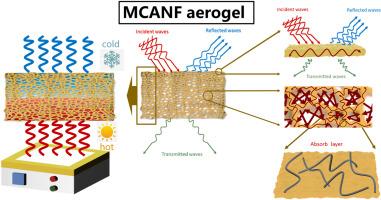双网芳纶纳米纤维/纤维素纳米纤维/MXene气凝胶轻量化,脉冲电磁干扰屏蔽
IF 9.8
1区 材料科学
Q1 MATERIALS SCIENCE, COMPOSITES
引用次数: 0
摘要
在不影响质量的情况下实现对大功率电磁脉冲(HEMPs)的有效屏蔽对于航空航天、国防和可穿戴系统至关重要,但对于大多数轻质材料来说仍然难以实现。在这项工作中,我们提出了一种由芳纶纳米纤维(ANFs)、纤维素纳米纤维(CNF)和MXene纳米片构成的多功能复合气凝胶。通过氢键和静电相互作用形成双网络结构,产生具有综合强度,柔韧性和电气功能的高度多孔结构。该气凝胶在60%应变下表现出0.48 MPa的特殊压应力,在x波段的宽带屏蔽效率超过90 dB(吸收贡献为90%),热稳定性高达150°C。基于连续波(CW)频域评估的传统屏蔽指标往往无法捕捉到这种情况下的材料行为。为了评估气凝胶的瞬态保护能力,我们进一步采用基于时域有限差分(FDTD)建模的时域屏蔽效率(TDSE)模拟。结果证实,在类似emp的照明下,气凝胶对电场峰值、导数和能量通量有很强的抑制作用,证明了气凝胶在高脉冲环境(如航空航天和国防系统)中的可行性。该研究为具有高性能电磁弹性的工程气凝胶提供了一个通用的、可扩展的平台,弥合了材料设计与实际操作需求之间的差距。本文章由计算机程序翻译,如有差异,请以英文原文为准。

Dual-network aramid nanofibers/cellulose Nanofibers/MXene aerogels for lightweight, pulse electromagnetic interference shielding
Achieving effective shielding against high-power electromagnetic pulses (HEMPs) without compromising mass is critical for aerospace, defence and wearable systems, yet remains elusive for most lightweight materials. In this work, we present a multifunctional composite aerogel constructed from aramid nanofibers (ANFs), cellulose nanofibers (CNF), and MXene nanosheets. A dual-network architecture is formed through hydrogen bonding and electrostatic interactions, yielding a highly porous structure with integrated strength, flexibility, and electrical functionality. The aerogel exhibits an exceptional compressive stress of 0.48 MPa at 60 % strain, broadband shielding effectiveness exceeding 90 dB in the X-band (with >90 % absorption contribution), and thermal stability up to 150 °C. Conventional shielding metrics based on continuous-wave (CW) frequency-domain evaluations often fail to capture material behavior under such scenarios. To evaluate the aerogel's transient protection capabilities, we further employed time-domain shielding effectiveness (TDSE) simulations based on finite-difference time-domain (FDTD) modeling. The results confirm strong suppression of electric field peaks, derivatives, and energy flux under EMP-like illumination, demonstrating the aerogel's viability in pulse-rich environments such as aerospace and defense systems. This study offers a versatile and scalable platform for engineering aerogels with high-performance electromagnetic resilience, bridging the gap between material design and real-world operational requirements.
求助全文
通过发布文献求助,成功后即可免费获取论文全文。
去求助
来源期刊

Composites Science and Technology
工程技术-材料科学:复合
CiteScore
16.20
自引率
9.90%
发文量
611
审稿时长
33 days
期刊介绍:
Composites Science and Technology publishes refereed original articles on the fundamental and applied science of engineering composites. The focus of this journal is on polymeric matrix composites with reinforcements/fillers ranging from nano- to macro-scale. CSTE encourages manuscripts reporting unique, innovative contributions to the physics, chemistry, materials science and applied mechanics aspects of advanced composites.
Besides traditional fiber reinforced composites, novel composites with significant potential for engineering applications are encouraged.
 求助内容:
求助内容: 应助结果提醒方式:
应助结果提醒方式:


